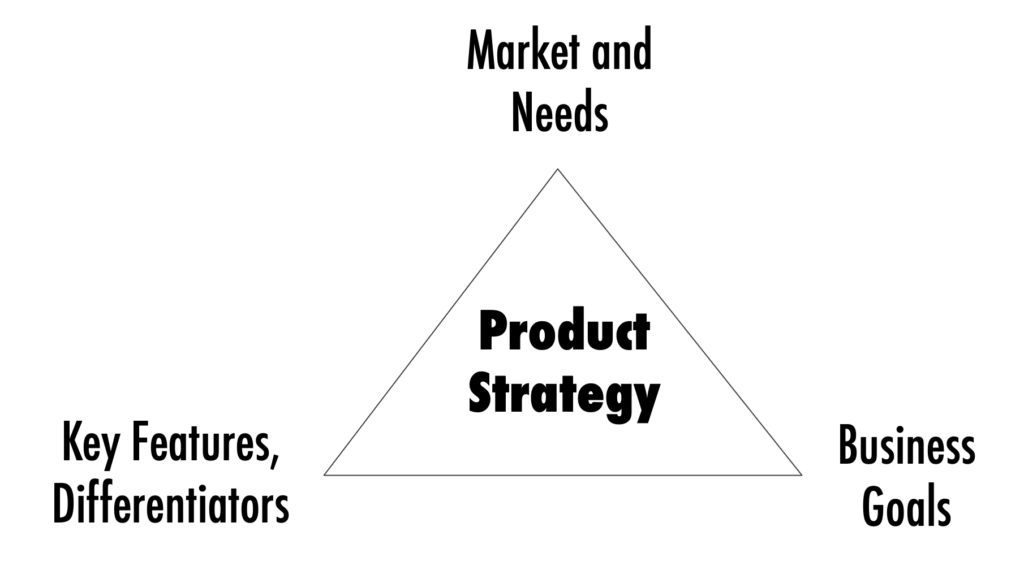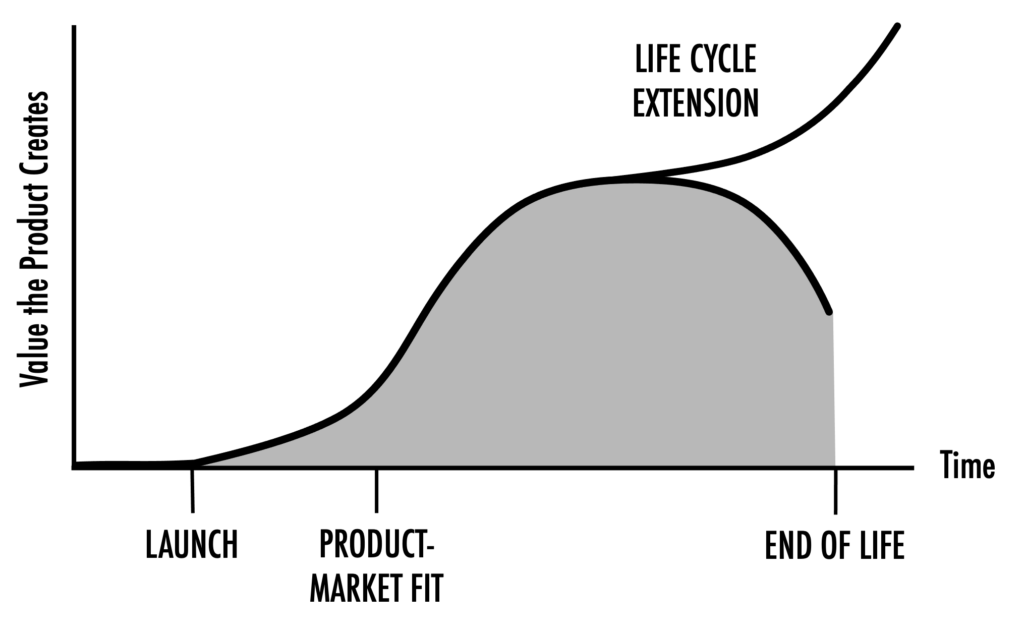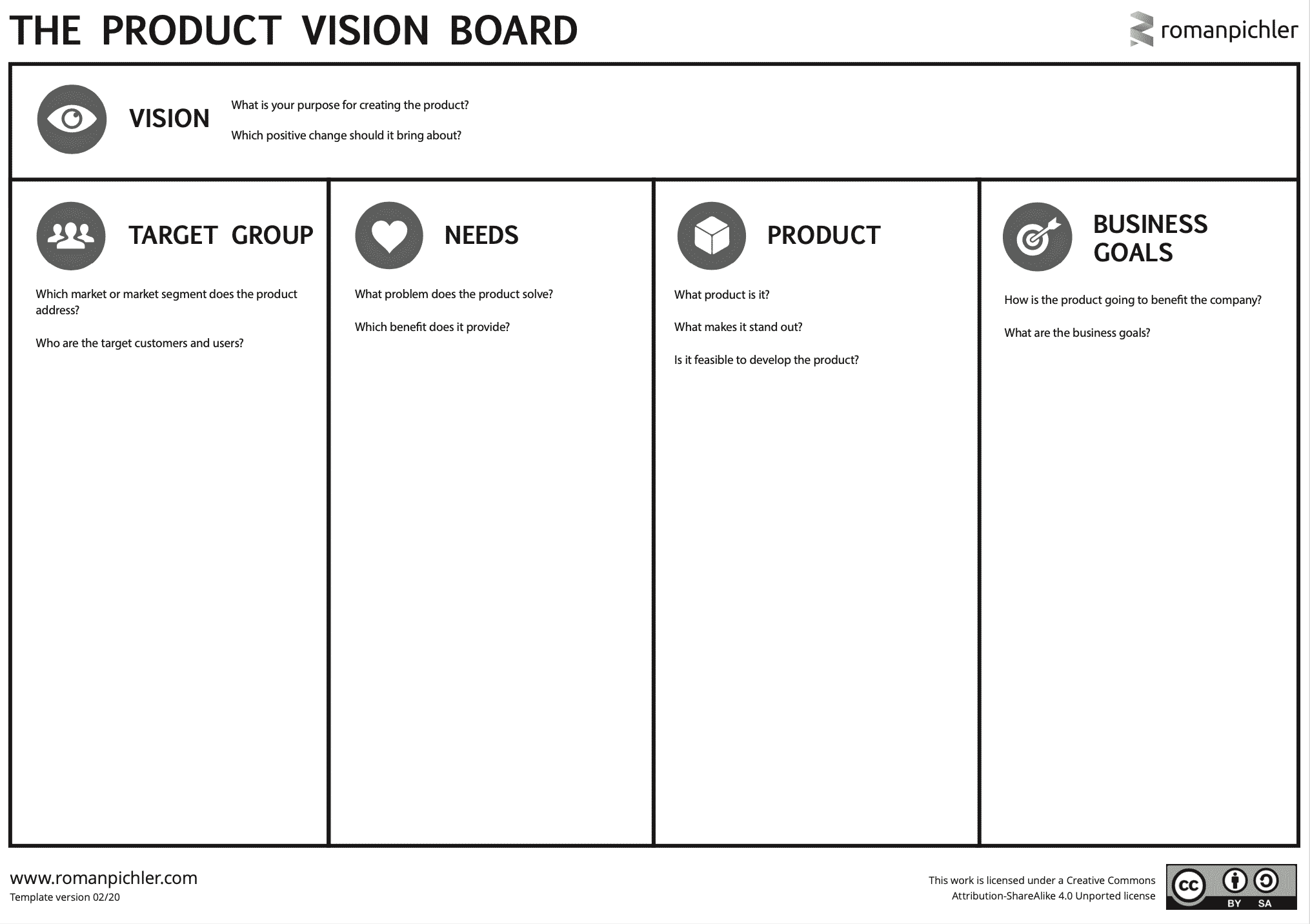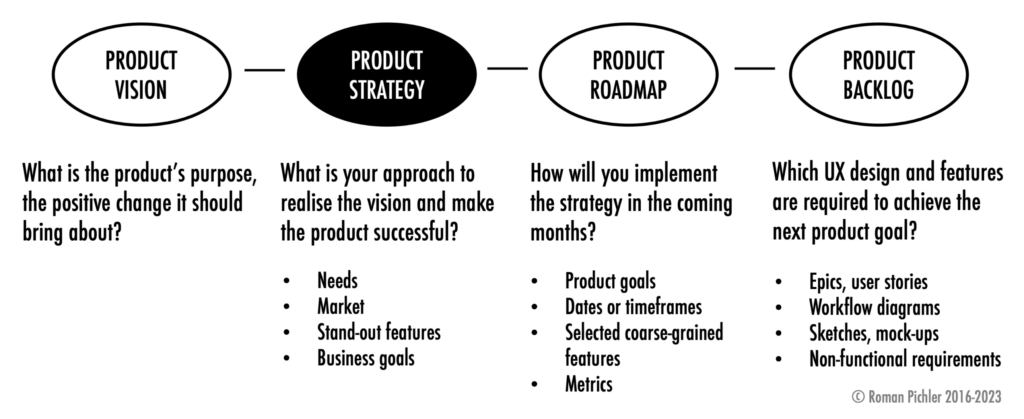Creating a successful product requires attention to the details, from getting the user interaction and the visual design right to providing the right functionality and using the right technologies. With so much focus on the nitty-gritty, it’s easy to no longer see the wood for the trees. This is where the product strategy comes in. It helps you manage your product proactively and it prevents you from getting lost in the details. This post discusses what an effective product strategy is and how it benefits you.
The Three Elements of an Effective Strategy
Product strategy is about imagining the future of your product: What offering will it become? Who will it benefit? How will it create value? It’s a high-level plan that helps you realise your vision or overarching goal. More specifically, the product strategy should describe who the product is for and why people would want to use and buy it; what the product is and what makes it stand out; and what the business goals are and why it is worthwhile for your company to invest in it, as the following picture shows.


In the picture above, the market describes the target customers and users of your product, the people who are likely to buy and to use it. The needs comprise the main problem your product solves or the primary benefit it provides. Think of a product like Google Search or Bing that solves the problem of finding information on the Internet. Compare it to a product like Facebook that allows you to stay in touch with family and friends.
The key features and the differentiators are those aspects of your product that are crucial to address the main problem or create the primary benefit and that make make it stand out from the crowd. Don’t make the mistake of creating a mini product backlog or a wish list. Instead focus on the three to five key aspects that make people choose it over competing offers. Take, for example, the first iPhone with mobile Internet, iPod-like digital music player, and touch screen as its key features; or the Google Chrome browser with its focus on speed, safety, and simplicity.
The business goals capture how your product is going to benefit your company. Is it going to generate revenue, help sell another product or service, reduce cost, or increase the brand equity? Being clear on the business goals helps you to select the right key performance indicators (KPIs) and measure your product’s performance.
Take the iPhone and the Google Chrome browser mentioned earlier. While the iPhone currently generates the largest portion of Apple’s revenue at the time of writing, the Chrome browser does not earn any money for Google. But it allows the company to control the way people access the Internet and it has reduced Google’s dependency on third-party browsers such as Mozilla Firefox and Microsoft Edge. Both are important business benefits.
A handy tool to capture your product strategy is my Product Vision Board, shown in the picture below. You can download it from romanpichler.com/tools/vision-board or by clicking on the image.
The Product Vision Board above captures the vision at the top. The four sections underneath it describe the product strategy. You can find more information on how to use the tool in the article The Product Vision Board and the video Introduction to the Product Vision Board.
Strategy Focus and Inflection Points
The product strategy is not a static, fixed statement or document that you create for a new product. It changes as your product grows and matures. The following picture shows the product life cycle with four key events: launch, product-market fit, life cycle extension, and end of life.


The strategy for a new product should first help you get to launch, then achieve product-market fit (PMF), and finally sustain the growth of your product. Think, for instance, of the changes Apple has made to the iPhone since its launch in 2007 to keep it attractive and preserve its growth, from adding apps to changing the its size and offering variants.
Once the growth starts to stagnate you have reached another strategic inflection point: You can either extend your product’s life cycle, for instance, by rejuvenating it or taking it to a new market, or you let it mature and eventually decline and die.
As your product evolves and changes, you should review and adjust the product strategy on a regular basis, at least once a quarter as a rule of thumb. This will help you proactively manage your product, guide the work of the stakeholders and development teams, and maximise the chances of achieving product success.
The Product Strategy in Context
If the product strategy describes the key elements required to develop a success product as I suggested above, then where are the vision and the product roadmap? My product strategy model in the picture below shows how I relate the artefacts.
In the model above, the vision is the ultimate reason for creating the product, the positive change it should bring about as I describe in more detail in my post “8 Tips for Creating A Compelling Product Vision”. If you think of the strategy as a path to the vision, then the vision guides the strategy.
Say I want to create an app that helps people become aware of what and how much they eat. The vision could be to help people eat healthily, and the strategy might be to create an app that reduces the risk of developing type-2 diabetes. But that’s not the only way to attain my vision. If it turns out that the app is not a great idea, I could pivot and write a book on healthy eating, for instance, while still following my vision.
As the picture above shows, the product strategy provides the input for the product roadmap. The roadmap states how the strategy is implemented and describes how the product is likely to grow. The two work in tandem: The roadmap states how you intend to implement the product strategy and the specific and measurable goals or outcomes your product should create in the coming months.
For example, I might derive the following product goals from product strategy of my healthy-eating app and capture it on the product roadmap: Help the users understand their eating habits and acquire an initial user base; help the users improve their eating habits and grow the user base; and help the users get fitter and generate revenue in form of in-app purchases. These goals show how the product is likely to grow and the specific outcomes it will provide.
The product roadmap, finally, creates the context for stocking and updating the product backlog, as I describe in more detail in the article The Product Roadmap and the Product Backlog.





Post a Comment or Ask a Question
20 Comments
Hi, I’d like to heartily thank you for your book Strategize because it is a step-by-step guide for me. Could you please offer guidance on how we introduce our new product in a mature market? Thanks for guiding me as a coach.
Ganesh Padgal.
Thanks for sharing your question and feedback, Ganesh. It’s great that you found Strategize helpful. When you enter a mature market with a new product, ensure that your product is effectively differentiated, that it stands out from the crowd and gives users and customers a clear reason to choose it over existing offerings. Additionally, consider any market-entry barriers like high switching costs for customers, and be aware that your initial offering will have to be rich enough to compete with the products of your competitors. I write about the latter in Strategize when I compare the development and launch of the iPhone and Apple Watch. Hope this helps!
How do you create a roadmap with dates with only course grained features/outcomes? Asking for a friend.
Thanks for sharing your friend’s question, Tom. I recommend that they read the following article, which discusses how to create an outcome-based, goal-oriented product roadmap with uses dates/time frames and coarse-grained features: The GO Product Roadmap. A more detailed explanation is available in my book Strategize.
Good learning about developing strategy and other areas of product development. Thank you.
You’re welcome Suresh and thanks for the feedback.
Hi Roman,
Thanks for your article. This is quite enlightening.
I often struggle asking the right set of questions and making right assumptions while consulting the customer on a new product, Can you please throw some light on what should be the right approach while defining a new product for the customers.
Thanks for your feedback Paritosh. Reading my article “Product Discovery Tips” should help you answer your questions. Good luck!
Hi Roman,
I liked your post. Very helpful ! You mentioned about Product Strategy being derived from the Vision of the company and then ultimately a roadmap to achieve that strategy. But how do you relate product strategy to business strategy ? Many times, even if we have a vision, there are intermediate focuses of businesses on a quarterly / half yearly basis and product needs to deliver to achieve those business strategy. So what do you think about: Vision -> Business Strategy -> Product Strategy -> Product Roadmap way of thinking ?
Hi Ani,
Thank you for your feedback and sharing your question. I like to work with the following model, which I describe in my book Strategize:
Vision -> business strategy -> product strategy -> product roadmap -> product backlog
If you can break down quarterly business goals into product goals and capture them on a product roadmap, depends on the product’s life cycle stage: Once your product grows steadily, you should be able to carry out this exercise (if it is helpful). Otherwise I recommend that you use a validated product strategy and actionable product roadmap to show how your product helps implement the business strategy and move the business in the right direction. Hope this helps!
Hello Roman,
Very interesting read. I am trying to learn more about the Product Quality strategy especially in the manufacturing context. It will be really helpful if you can guide me further on this topic. It will be interesting to see a developed model and how it behaves taking into consideration various dimensions of Quality. Using this framework how to develop a product quality strategy in accordance with the overall product strategy.
Your inputs will be highly appreciated
Hi Sandy,
Thanks for your comment. Unfortunately, I am neither a production nor a quality expert. But I would suggest that if quality is a differentiator for your product, you include it in your product strategy (and list it in the “Product” section if you use the Product Vision Board).
Hope this helps!
Thanks, i also love your book and your work. please can you guide me on product strategies for effectve performance of agro- based SMEs.thanks
Thanks for your feedback Fred. I am sorry but I am not an expert on agro-based products. But I hope that you can apply the techniques and tools that I discuss in my articles and books in your industry. Additionally, take a look at my article “Five Tips for Introducing Product management to Your Company“. Hope this helps!
I like your framework and I loved your book.
Who should define the product strategy?
I work in a startup as the only product leader and I’m transitioning to a role of product marketing. The more I spend time on this the more it seems natural to me that the strategy may be a product marketing task, since I have much more inputs and clearer mind now than as a busy product owner.
What do you think?
Thanks for your feedback and comment Ivan. As the product manager in charge of the product, you should own the product’s strategy. But as I explain in Strategize, I recommend involving the key stakeholders, including product marketing, in important strategic decisions.
Does this help?
So you would not include business model as part of strategy discussion ?
Great question, thanks for asking. If the product requires a new or changed business model, then I would include it in the strategy discussion. That’s typically the case when a brand-new product is developed and when the life cycle of an existing one is extended (for instance, by taking it to a new market). But I would recommend clearly distinguishing between product strategy and business model. The former should focus on the product’s value proposition and business goals, whereas the latter explains how the product is monetised. I discuss the relationship between the product strategy and business model in more detail in my book Strategize. Hope this helps!
I would think the more appropriate order is Vision >> BUSINESS MODEL >> Product Strategy >> Roadmap
Without the fully fleshed out business model, your product strategy may become too myopic on the product aspects for the sake of product…Missing opportunities to innovate the product to achieve the business model goals.
Hi Mike, Thanks for your comment. If you have a business model that you want to use or make work, then the product strategy should be derived from the business model. An example is the original iPod: The sales took off and the business model succeeded after the launch of iTunes in 2003. But I find it no unusual that a company has a great idea for a new product and is looking for the right business model to monetise it. Take Google Search and Facebook as examples. Both products were launched without a working business model in place. As the topic deserves a separate blog post, I have adjusted the text and removed the business model discussion.